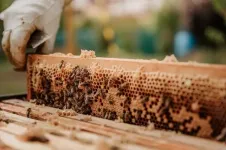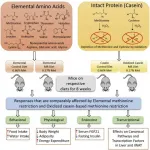Sheltering people with COVID-19 experiencing homelessness curbs spread
2021-05-20
(Press-News.org) A new study provides public health planning authorities with a method of calculating the number of COVID-19 isolation beds they would need for people experiencing homelessness based on level of infection in the city. The research holds promise for controlling spread of the virus - or future infectious diseases - in a population that is highly vulnerable and less likely than many others to access health care services.
The report, developed to support public health decision-making in Austin, Texas, was recently published by PLOS ONE. The paper's first author is an undergraduate student at The University of Texas at Austin, Tanvi Ingle, who harnessed her days in the pandemic lockdown to work with researchers in The University of Texas at Austin COVID-19 Modeling Consortium.
"Our model can help Austin and other cities ensure they have sufficient resources to protect populations experiencing homelessness during future disease outbreaks," said Lauren Ancel Meyers, director of the UT Austin COVID-19 Modeling Consortium and a professor of integrative biology. "Our calculations indicated how many hotel rooms would be needed to isolate individuals when they developed symptoms or were exposed to the virus. Given that this community generally has high contact rates, poor health care and lack of privacy, these isolation facilities were critical to preventing transmission and protecting this vulnerable population."
Projections based on the model were provided to the City of Austin during the beginning of the pandemic and helped the city finalize lease agreements for isolation facilities.
"The projections from the UT COVID-19 Modeling Consortium were invaluable to us in determining the potential impact and magnitude of support needed to prevent a catastrophic impact on people experiencing homelessness in Austin," said Dr. Mark Escott, the City of Austin's chief medical officer. "As a result, multiple area hotels were used as protective lodges to provide non-congregate sheltering to the most vulnerable members of our community."
Before the lockdown, the undergraduate first author, Ingle, served as a clinical volunteer with Dell Medical School at the C.D. Doyle Clinic, a student-run free clinic that provides care to people experiencing homelessness. When the lockdown hit, she responded to a campus-wide call for help from the newly formed UT COVID-19 Modeling Consortium. Ingle volunteered to lead a research project that could help the homeless population navigate the challenges of the pandemic.
"From my clinical experiences, I knew that the pandemic would be especially hard for people who experience homelessness since they face unique challenges in social distancing and accessing health care. Eager to help improve the situation, I collaborated with the consortium and the City of Austin to determine how many isolation rooms we should provide to help protect our unhoused neighbors from COVID-19," Ingle said.
Using the mathematical model of COVID-19 transmission developed by the consortium, the City of Austin could determine what proportion of people experiencing homelessness would need to be tested and how many of those individuals would test positive. With these parameters, they were then able to estimate the total number of individuals who would need an isolation room at any given time.
"This project was a way for me to see firsthand how clinical experiences inform scientific research that impacts public health outcomes," Ingle said. "Cities around the world will be able to adapt our framework to help shape public policies in the early stages of any pandemic."
"UT undergraduates have stepped up as researchers and leaders throughout the COVID-19 pandemic," Meyers said. "Tanvi is an inspiring example. Her calculations helped the City of Austin to protect some of its most vulnerable populations."
INFORMATION:
Contributors to the report in addition to Ingle and Meyers were former UT Austin undergraduate Maike Morrison (now at Stanford University); Austin's Xutong Wang, Timothy Mercer and Spencer Fox; and Vella Karman of Austin Public Health.
This study was supported by funding from the Centers for Disease Control and Prevention and the National Institutes of Health. Tito's Handmade Vodka provided support for the staff. The Texas Advanced Computing Center at The University of Texas at Austin provided resources that contributed to the research results. Meyers holds the Denton A. Cooley Centennial Professorship and also an appointment in the Department of Statistics and Data Sciences.
ELSE PRESS RELEASES FROM THIS DATE:
2021-05-20
In April 2017, a landslide in Mocoa, Colombia, ripped through a local town, killing more than 300 people. Nicolás Pérez-Consuegra grew up about 570 miles north in Santander, Colombia, and was shocked as he watched the devastation on television. At that time, he was an undergraduate intern at the Smithsonian Tropical Research Institute in Panama. As a budding geologist raised hiking the tropical mountains of Colombia, he wondered, what causes greater erosion in some areas of the mountains than in others? And, is it tectonic forces - where Earth's tectonic plates slide against one another leading to the formation of steep mountains - or high precipitation rates, that play a more important role in causing erosion within that region?
To answer those questions would require a geological ...
2021-05-20
Scientists have discovered that the way in which neurons are connected within regions of the brain, can be a better indicator of disease progression and treatment outcomes for people with brain disorders such as epilepsy.
Many brain diseases lead to cell death and the removal of connections within the brain. In a new study, published in Human Brain Mapping, a group of scientists, led by Dr Marcus Kaiser from the School of Medicine at the University of Nottingham, looked at epilepsy patients undergoing surgery.
They found that changes in the local network within brain regions can be a better predictor ...
2021-05-20
More than 90 years ago, astronomer Edwin Hubble observed the first hint of the rate at which the universe expands, called the Hubble constant.
Almost immediately, astronomers began arguing about the actual value of this constant, and over time, realized that there was a discrepancy in this number between early universe observations and late universe observations.
Early in the universe's existence, light moved through plasma--there were no stars yet--and from oscillations similar to sound waves created by this, scientists deduced that the Hubble constant was about 67. This means the universe expands about 67 kilometers per second faster every 3.26 million light-years.
But this observation differs when scientists look at the universe's ...
2021-05-20
BOSTON - Dana-Farber Cancer Institute researchers are presenting dozens of research studies at the 2021 Annual Meeting of the American Society of Clinical Oncology (ASCO). The studies will be presented during the virtual program on June 4-8, 2021. ASCO is the world's largest clinical cancer research meeting, attracting more than 30,000 oncology professionals from around the world.
Toni K. Choueiri, MD, the director of the Lank Center for Genitourinary Oncology at Dana-Farber, will present results from the randomized, double-blind, phase III KEYNOTE-564 trial evaluating pembrolizumab versus placebo after surgery in patients with renal cell carcinoma (abstract LBA5) during ASCO's Plenary Session on Sunday, June ...
2021-05-20
CHAMPAIGN, Ill. -- Solid-state batteries pack a lot of energy into a small space, but their electrodes are not good at keeping in touch with their electrolytes. Liquid electrolytes reach every nook and cranny of an electrode to spark energy, but liquids take up space without storing energy and fail over time. Researchers are now putting solid electrolytes in touch with electrodes made of strategically arranged materials - at the atomic level - and the results are helping drive better solid-state battery technologies.
A new study, led by University of Illinois Urbana-Champaign materials science and engineering professor Paul Braun, postdoctoral research associate Beniamin Zahiri, and Xerion Advanced Battery Corp. director of research and development ...
2021-05-20
The University of Maryland (UMD) co-published a new review paper in the Annual Review of Resource Economics to examine pollinators from both an economic and ecological perspective, providing much needed insight into the complexities of valuing pollination. Pollinators are not only a critical component of a healthy ecosystem, but they are also necessary to produce certain foods and boost crop yields. While native and wild pollinators (whether they be certain bee species, other insects and animals, or just the wind) still play an important role, managed honey bee colonies are commercially trucked around the U.S. to meet the need for pollination services in agricultural products. Recent reports of ...
2021-05-20
BATON ROUGE, Louisiana - A diet that improves the biomarkers of metabolic health, and that could potentially slow the aging process, has moved a step closer to reality.
"We've known for years that restricting the amino acid methionine in the diet produces immediate and lasting improvements in nearly every biomarker of metabolic health," said Thomas W. Gettys, PhD, Professor and Director, Nutrient Sensing and Adipocyte Signaling Laboratory at Pennington Biomedical Research Center. "The problem is that methionine-restricted diets have been difficult to implement because they taste so bad."
Until now. Restricting methionine normally involves diets formulated with elemental (e.g., individual) amino acids. Individual amino acids are the building blocks ...
2021-05-20
May 20, 2021 - Women with a history of weight cycling - losing and regaining 10 pounds or more, even once - have increased rates of insomnia and other sleep problems, reports a study in The Journal of Cardiovascular Nursing, official journal of the Preventive Cardiovascular Nurses Association. The journal is published in the Lippincott portfolio by Wolters Kluwer.
"History of weight cycling was prospectively associated with several measures of poor sleep, including short sleep duration, worse sleep quality, greater insomnia, greater sleep disturbances, ...
2021-05-20
Melting glaciers and polar ice sheets are among the dominant sources of sea-level rise, yet until now, the water beneath them has remained hidden from airborne ice-penetrating radar.
With the detection of groundwater beneath Hiawatha Glacier in Greenland, researchers have opened the possibility that water can be identified under other glaciers from the air at a continental scale and help improve sea-level rise projections. The presence of water beneath ice sheets is a critical component currently missing from glacial melt scenarios that may greatly impact how quickly seas rise - for example, by enabling big chunks of ice to calve ...
2021-05-20
New research led by the University of Kent's School of Psychology has found that some brain activity methods used to detect incriminating memories do not work accurately in older adults.
Findings show that concealed information tests relying on electrical activity of the brain (electroencephalography [EEG]) are ineffective in older adults because of changes to recognition-related brain activity that occurs with aging.
EEG-based forensic memory detection is based on the logic that guilty suspects will hold incriminating knowledge about crimes they have committed, and therefore their brains will elicit a recognition response ...
LAST 30 PRESS RELEASES:
[Press-News.org] Sheltering people with COVID-19 experiencing homelessness curbs spread




